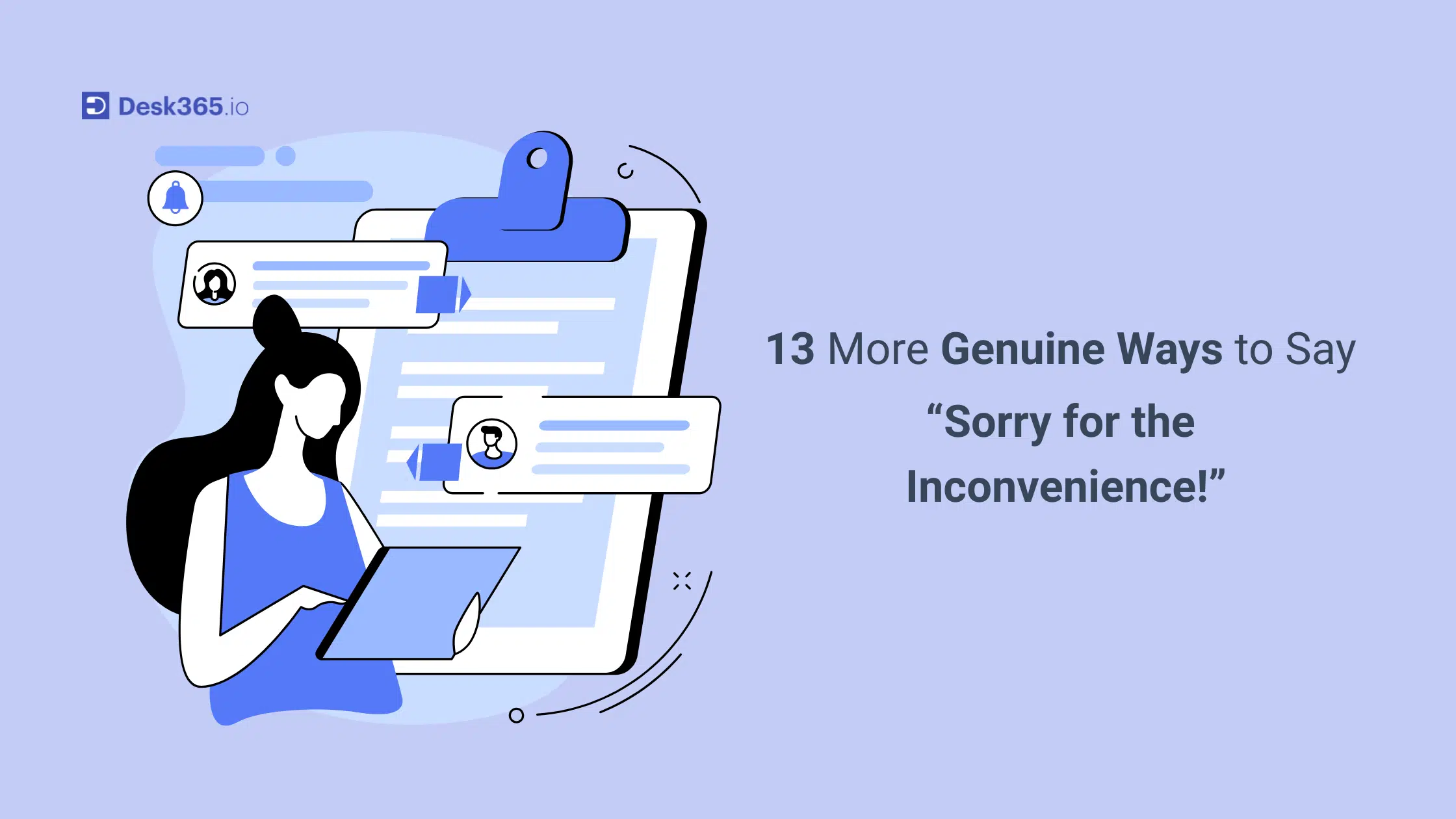As a business, providing excellent service means not only delivering on promises but also handling mishaps with grace and empathy. When things go wrong, saying “Sorry for the inconvenience” might feel like the obvious choice. But let’s be honest—customers can hear that phrase a lot, and it doesn’t always feel personal or thoughtful.
To truly connect and show that you care, it’s important to offer a more human touch when apologizing. In this blog post, we’ll share 13 alternative ways to say “Sorry for the inconvenience” that will help you express genuine regret, restore trust, and keep your customer relationships strong.
Why sincere apologizing matters to your customers?
When something goes wrong, how you apologize can make all the difference in maintaining a strong customer relationship. A sincere, thoughtful apology goes a long way in turning a negative experience into a positive one. Research from PWC also found that 32% of all customers would stop doing business with a brand they loved after one bad experience. That means, when apologizing, it’s crucial to be personal and empathetic, making the customer feel heard and appreciated.
Quick fix: they want to feel valued and understood. A generic “Sorry for the inconvenience” can often come off as impersonal, leading customers to feel like their concerns are not being taken seriously. On the other hand, a sincere apology shows that you acknowledge their frustration and are genuinely working to make things right.
Why “sorry for the inconvenience” isn’t always enough
We’ve all heard it before: “Sorry for the inconvenience.” It’s a phrase that’s commonly used in customer service, but here’s the thing—it’s become so overused that it can often feel impersonal, even robotic. When something goes wrong, customers are looking for more than just a standard apology.
They want to feel like their concerns are heard, that their frustration is understood, and most importantly, that something is being done to fix the issue.
Using a simple, generic apology like “Sorry for the inconvenience” can come off as dismissive, as if you’re just going through the motions. It doesn’t show the level of empathy and commitment that customers truly deserve. Plus, it doesn’t help build a connection or restore trust.
What customers want is an apology that acknowledges the real impact of the issue, expresses genuine regret, and shows that you’re actively working to make things right. That’s why we need to move beyond the standard “sorry” and start using phrases that feel more human, personal, and sincere.
A thoughtful apology can turn a negative experience into an opportunity to strengthen the relationship and show customers that you care.
The art of apologizing: 13 ways to sound more genuine
“Oops, our mistake! We’re on it and fixing things.”
“We’re really sorry for any hassle this may have caused.”
“We completely understand how frustrating this is, and we’re on it.”
“This shouldn’t have happened, and we’re truly sorry.”
“Thanks for your patience while we work through this!”
“We regret that we missed the mark this time.”
“We know this isn’t the experience you expected, and we’re sorry.”
“We’re sorry for the trouble; we’re working on it.”
“Sorry for the hiccup! We’re working to fix it.”
“We realize this is inconvenient, and we appreciate your understanding.”
“We completely get how frustrating this must be. We’re fixing it now.”
“We’re genuinely sorry for the delay and the disruption.”
“We understand how disappointing this is, and we’re here to fix it.”
1. Oops, our mistake! We’re on it and fixing things.
Sometimes, things go wrong, and it’s totally okay to admit it with a little bit of humor. By saying “Oops,” you’re making it clear that you’re human and acknowledging the mistake in a light-hearted way. It shows that you’re actively fixing it without sounding too formal.
Dear [Recipient’s Name],
Oops, our mistake! We’ve noticed the issue and are already working hard to resolve it. Please rest assured that we’re on it and will have it fixed as soon as possible.
Thank you for your understanding, and we apologize for any inconvenience this may have caused.
Best regards,
[Your Name]
2. We’re really sorry for any hassle this may have caused.
This one’s all about recognizing that you’ve caused some unnecessary trouble. You’re acknowledging how much of a hassle it is and offering a genuine apology. It’s a simple, heartfelt way to show you care about their time and experience.
Dear [Recipient’s Name],
We’re really sorry for any hassle this may have caused. We understand how frustrating this can be and we’re working to resolve it as quickly as we can.
Thank you for your patience and understanding.
Sincerely,
[Your Name]
3. We completely understand how frustrating this is, and we’re on it
This apology focuses on truly understanding the customer’s frustration. It’s not just about fixing the problem—it’s about showing them you get it. When you acknowledge their frustration, it makes them feel heard and cared for.
Dear [Recipient’s Name],
We completely understand how frustrating this is, and we’re already working on a solution. Please know that we’re doing everything possible to resolve the issue as quickly as possible.
We appreciate your patience during this time.
Best,
[Your Name]
4. This shouldn’t have happened, and we’re truly sorry.
This one is as straightforward as it gets. It’s not about making excuses but owning up to what went wrong. You’re simply saying, “This should not have happened, and we’re sorry it did.” It’s genuine and takes full responsibility.
Dear [Recipient’s Name],
This shouldn’t have happened, and we’re truly sorry for the inconvenience this has caused. We take full responsibility and are currently working to ensure it doesn’t happen again.
Thank you for your understanding.
Kind regards,
[Your Name]
5. Thanks for your patience while we work through this!
Sometimes the best way to apologize is to simply thank the customer for their patience. Acknowledging their patience shows you appreciate their understanding and gives them a little credit for their own role in the process.
Dear [Recipient’s Name],
Thank you for your patience while we work through this. We are addressing the situation and appreciate your understanding as we resolve it.
We’ll be sure to keep you updated.
Best regards,
[Your Name]
6. We regret that we missed the mark this time.
A little more formal, but still human, this phrase acknowledges that you didn’t live up to expectations. It shows that you care about the standard you set and that you’re working hard to do better next time.
Dear [Recipient’s Name],
We regret that we missed the mark this time. We understand how this can be frustrating, and we’re working to fix the situation and ensure it doesn’t happen again.
Thank you for your continued support.
Sincerely,
[Your Name]
7. We know this isn’t the experience you expected, and we’re sorry.
This apology focuses on the customer’s expectations. You’re recognizing that what they got isn’t what they expected, and that can be disappointing. It shows empathy and that you care about delivering the experience they deserve.
Dear [Recipient’s Name],
We know this isn’t the experience you expected, and we’re sorry for the inconvenience caused. We’re addressing the issue and will make sure to improve in the future.
Thank you for your understanding.
Best,
[Your Name]
8. We’re sorry for the trouble; we’re working on it.
This one’s short, sweet, and to the point. You’re admitting that the customer had trouble and that you’re on it. It’s a quick acknowledgment that you’re working to fix things, without overloading them with too many details.
Dear [Recipient’s Name],
We’re sorry for the trouble this has caused, and we want to assure you that we’re working hard to resolve it. Your patience is greatly appreciated.
Kind regards,
[Your Name]
9. Sorry for the hiccup! We’re working to fix it.
This is a lighter, more casual way to say sorry. Sometimes a little humor goes a long way in making the situation feel less stressful. “Hiccup” is a fun word that can soften the situation, making it feel less formal and more approachable.
Dear [Recipient’s Name],
Sorry for the hiccup! We’re working to fix it and will have it resolved soon. Thank you for your patience, and we appreciate your understanding during this time.
Best,
[Your Name]
10. We realize this is inconvenient, and we appreciate your understanding.
This apology recognizes the inconvenience caused to the customer, but it also focuses on expressing gratitude for their patience. It shows that you understand it’s a hassle, but you’re thankful for their calm attitude.
Dear [Recipient’s Name],
We realize this is inconvenient, and we truly appreciate your understanding while we resolve the issue. We’re doing everything we can to address it promptly.
Thank you for bearing with us.
Best regards,
[Your Name]
11. We completely get how frustrating this must be. We’re fixing it now.
Here, you’re putting yourself in the customer’s shoes. Saying, “We completely get how frustrating this must be” lets them know you understand their point of view. It shows you’re not just offering a generic apology—you’re empathizing with them.
Dear [Recipient’s Name],
We completely get how frustrating this must be, and we’re already fixing it. We appreciate your patience while we work on a resolution.
Thank you for your understanding.
Sincerely,
[Your Name]
12. We’re genuinely sorry for the delay and the disruption.
When an issue causes a delay, it can really throw off a customer’s plans. This apology is genuine and takes full responsibility for both the delay and any disruption caused. It shows that you understand the ripple effect and are making it right.
Dear [Recipient’s Name],
We’re genuinely sorry for the delay and the disruption this has caused. Please know we are doing everything we can to resolve the situation.
Thank you for your patience.
Best,
[Your Name]
13. We understand how disappointing this is, and we’re here to fix it.
This one really digs into empathy. It acknowledges that the customer is likely feeling disappointed, and you’re not just saying “sorry”—you’re offering reassurance that you’re actively addressing the issue. It makes them feel heard and supported.
Dear [Recipient’s Name],
We understand how disappointing this is, and we’re here to fix it. We are working on a solution and will keep you updated throughout the process.
Thank you for your patience and understanding.
Warm regards,
[Your Name]
Improve customer service interaction with right tools
When you send a “sorry for the inconvenience” message, your main goal should be simple: win the customer back. That means giving it your full effort—nothing less.
We didn’t come up with anything groundbreaking in our examples. They’re just everyday words, delivered with a bit more personality. Stick to the basics: use the customer’s name, be kind, be clear, and offer real solutions. And don’t pad your apology with empty phrases. If a mistake was made, it’s okay to admit it.
If you want to get better at this kind of communication, having the right tools helps a lot. Give Desk365 a try—start a free 21-day trial and see how it can help you talk to your customers in a way that actually connects.







